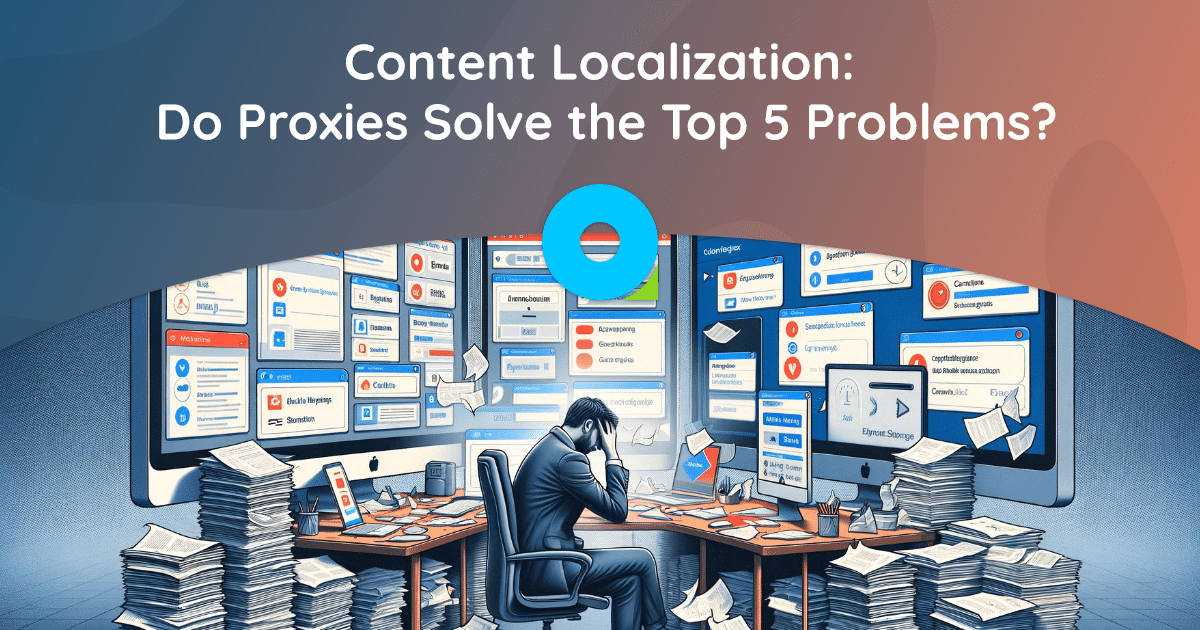
Have you ever wondered how companies with global aspirations enter new markets? If, well, very briefly, then they do it 1) long, hard and difficult, and 2) resorting to content localization, among other things. Although I would even say that the second point plays one of the most important roles in the business expansion strategy. Adapting information to different languages, cultures and regions is key to resonating with diverse audiences. However, when businesses embark on this path, they often encounter many problems that can ultimately make the process even more complex than what I had in mind in the first point.
What can help? Of course, proxy servers! These versatile tools give companies the ability to direct their online activity through servers in different parts of the world, giving the impression that they are accessing the Internet from different geographic locations. But let’s face it, even proxies – despite the invaluable business expansion support they provide – have their own set of problems when it comes to content localization.
Let’s go into a little more detail!

#1 IP address geolocation accuracy
For companies, proxy servers are an invaluable tool for virtually moving your online presence to different regions. However, the geolocation accuracy of IP addresses can sometimes be insufficient, which can potentially lead to inappropriate content anchors that simply will not resonate with the target audience.
Inherent inaccuracy
The fact is that IP geolocation – the process of determining the physical location of an IP address – is not always reliable… Various factors contribute to inaccuracy, including the assignment of IP address blocks to certain regions, the use of virtual private networks (VPNs), or even discrepancies in database entries.
As a result, a proxy server can only sometimes accurately determine the geographic location of its users, making it difficult to provide content that is truly relevant to local audiences.
Risk of non-compliance
If your message is not precisely localized, it may not resonate with your target audience. Language, cultural references and format preferences may not correspond to local norms.
For example, a website intended for users in Japan might display something written in Japanese. However, if the IP geolocation incorrectly indicates that the user is located in Brazil, it is clear that the article will miss the target attention.
The role of proxy selection
If your company strives for precise localization, you should carefully consider your choice of proxy servers. Not all of them provide the same level of geolocation accuracy.
Residential proxies that use real IP addresses tend to provide more accurate location information than server-based proxies. However, their cost is higher. Balancing cost, accuracy, and scalability is a critical business consideration.
Have you decided to move from words to action ALREADY? Then you need to go straight to reviews of the best proxy providers!
Solution to the problem!
- Reserving multiple proxies: By using multiple proxy servers from different locations at the same time, you can increase your chances of getting accurate geolocation. This redundancy ensures that even if one proxy’s geolocation is inaccurate, another can provide the correct location.
- Regular database updates: It is critical to keep geolocation databases up to date. You can subscribe to services that provide the most relevant IP location data, thereby minimizing inaccuracies caused by outdated information.
- User input confirmation: Enabling user input validation can further improve localization. By allowing users to manually select their preferred region or language, your company can bypass inaccuracies in geolocation data.
- Localized Variations: For important localized ideas and messages, consider creating variations that appeal to a broader regional audience rather than being too specific to one city. With this approach, you will be much more flexible and versatile, and will not depend on any inaccuracies in geolocation.

#2 Cultural differences and language difficulties
Content localization is a multifaceted job that goes beyond simple translation. It involves understanding and adapting to the unique linguistic and cultural background of your target audience.
Yes, in the context of global business expansion, proxies play a key role in facilitating your access to different regions. But, as you understand, adapting to local languages and cultural characteristics is not part of their functionality…
Beyond simple translation
Effective content localization requires a comprehensive understanding of the target culture, including its history, traditions, values, and idiomatic expressions.
It’s just like with programming languages: each has a unique code, and a C++ programmer might have trouble understanding what a LISP expert is doing (while an HTML expert might question their very existence). . The same thing happens when a certain text in Romanian is translated into Korean or from Ukrainian into Swati. They may not even have words to denote the same object or phenomenon, or the problem may be some phrases and expressions unique only to a particular language that do not exist in our cultural field.
Thus, more than word-for-word translation of information is required; it must be culturally relevant to truly resonate with local audiences.
Problems of linguistic nuances
Linguistic nuances are complex and unique to each region. Synonyms, idioms, and colloquialisms vary, and misinterpretation may result in unintentional humor or offense. Proxy servers, while invaluable for their geolocation capabilities, can only sometimes decipher these linguistic subtleties. This is where human intervention and cultural experience become indispensable.
Remember that what may be harmless in one culture may be deeply offensive in another. Yes, proxy solutions, so to speak, lack the cultural awareness to understand these subtleties.
Visual and aesthetic preferences
Choices of color, imagery, and design elements can have different connotations in different cultures. Proxies are limited in adapting visuals to suit these cultural preferences, making human intervention indispensable in this aspect of localization.
Proxy and language problems
While proxy servers are excellent at routing online activity across different regions, they cannot interpret and tailor your content message to suit local languages and cultural nuances. Proxy servers can make it easier to access local websites, but they do not have the cultural awareness and linguistic knowledge needed for comprehensive content localization.
What about linguistic and cultural nuances?
As my and my colleagues’ practice shows, you should consider the following strategies:
- Human analysis and adaptation: Engage language and cultural experts who can review and adapt your materials to ensure they take into account local nuances. This applies not only to linguistic difficulties, but also to cultural references, idioms and humor.
- Local cooperation: Work collaboratively with local teams or individuals in a location who understand the culture and language of the target audience. Their knowledge is invaluable in tailoring your posts to suit local preferences.
- Constant feedback: Create a feedback channel that allows users to provide input on the relevance and cultural fit of something. This feedback can inform ongoing localization efforts.
- Content variations: Create varied variations to target a wider regional audience. By providing culturally relevant options, you can ensure (or at least significantly increase the chances) that your content will be more adaptable.
- Regular content audit: Periodically review your content for cultural and linguistic appropriateness (not just text, but also images, graphics, and design elements).

#3 Data Privacy and Compliance
On the one hand, proxies play an important role in expanding the cross-border digital presence of a business. On the other hand, it is the direction of online activity through different IP addresses that introduces additional complexity…
Multifaceted regulatory framework
Data privacy and compliance regulations are far from uniform. They differ significantly and depend on the specific country. However, some regions of one country may have strict rules for protecting user data, while others may have more liberal standards. If your company expands into new markets, you must carefully evaluate and comply with specific laws governing data privacy and content localization.
Proxy problem
By routing web traffic through servers in different locations, such decisions can expose companies to conflicting legal obligations. For example, if a company uses a proxy server located in a country with strict data privacy laws to access content in another region, it may inadvertently violate the rules of the target country.
How proxies can ensure compliance
So what can you do as a company:
- Selecting a proxy depending on the region: Choose proxy providers that provide location accuracy. By using proxy servers specifically located in the region you’re targeting, you can minimize the risk of violating local data privacy laws. This approach ensures that your online activity complies with the regulations of the target region.
- Data encryption: Implement strong data encryption protocols to protect user information when accessing content through a proxy. Encryption improves security and can help prevent potential data breaches or compliance violations.
- Accounting and audits: Implement comprehensive control of all your online activities using a proxy. If necessary, this record can be invaluable in demonstrating your commitment to compliance and data protection.
- Legal expertise: Engage lawyers who are well versed in the data privacy regulations in the regions where you are entering. Their advice can help you navigate complex compliance issues and avoid legal pitfalls.
- Regular conformity assessments: To ensure continued compliance with regional data privacy requirements, periodically evaluate all your efforts and steps to comply with these requirements. Conducting regular compliance assessments is important, especially with ever-changing data privacy legislation.
The problem of cross-border data transfer
One of the significant problems that arise when using proxy servers is cross-border data transfer. When content is localized using proxy servers, this most often involves transferring data across international borders. This process must comply with specific legal requirements in both the source and target regions.
Protecting User Consent
Compliance with data confidentiality rules also entails obtaining the user’s consent to collect and process data. Your company should be as transparent as possible about the data you collect, how it will be used, and provide mechanisms for users to opt-in (to collection and processing) or opt-out.
The final point to make here is that using proxies to bypass user consent mechanisms is strongly discouraged, as doing so may result in non-compliance and potential legal consequences.

#4 Proxy Performance: Balancing Localization and Speed
While proxy servers are useful for expanding a business’s digital reach by localizing content, they do pose another challenge: maintaining fast loading times for localized information. You have to maintain a delicate balance between localization activities and the need for fast delivery…
Need for speed
In the digital age, speed is of the utmost importance, don’t you agree? User expectations for fast page loading and content access are extremely high. Slow loading times can lead to frustration, irritation, increased bounce rates, and an overall poor user experience. This problem is further amplified when content is localized, where additional levels of complexity are introduced.
Proxy servers and performance impact
At their core, proxies represent an additional step in the content discovery process. When a user accesses content through a proxy, the request is routed through the proxy first before reaching the target website. Your company needs this routing for regional access, and for users it can slow down the delivery of information.
Localized variations
As you already know from this article, creating variations tailored to different regions is one of the main content localization strategies. These variations may include different languages, cultural references, and formats. Managing these variations can be challenging for you as they need to be delivered quickly without compromising the user experience.
Global content delivery networks (CDNs)
Companies often use content delivery networks (CDNs) to improve transfer speeds. CDNs cache information on servers distributed around the world, allowing users to access content from a nearby server, significantly reducing latency.
However, remember that incorporating a CDN into your strategy requires careful coordination to ensure efficient caching and delivery of localized information!
Achieving a balance between speed and performance
I recommend you the following:
- CDN integration: To speed up content delivery, use a CDN with locations around the world. Make sure your CDN is configured to efficiently cache and deliver localized content.
- Caching: Implement effective caching mechanisms that store frequently accessed content. Caching can significantly reduce the loading time of localized content and improve the user experience.
- Content optimization: Optimize your content for speed by minimizing unnecessary elements, compressing images, and ensuring code efficiency. This approach is critical for fast loading, especially when serving localized variations.
- Proxy load balancing: To effectively distribute traffic between proxy servers, use load balancing techniques. It aims to ensure that no server is overloaded, as this could negatively impact speed and performance.
- Regular performance testing: Conduct regular testing to identify weaknesses and latency issues in the content delivery process. Testing helps in adjusting and refining the localization strategy to achieve optimal speed.
Monitoring and continuous improvement
Speed and performance are not static goals; they require constant monitoring and improvement. By closely monitoring the speed and performance of your localized content, you can quickly identify areas that need optimization and ensure that users can access your content quickly and without any problems.

#5 Scalability and resource management
In the context of regional access, proxy servers operate at 10/10. But sometimes, on the contrary, they can even hinder your efforts to localize content…
Resource-intensive nature of localization
Scaling involves allocating resources to various tasks, including translation, content adaptation, and quality control. It also requires managing multiple variations of content, each tailored to specific regions. The complexity and complexity of these tasks can lead to resource shortages.
The proxy paradox when scaling
Proxy servers play an important role in content localization by making content available in different regions. However, they can also represent a very paradoxical phenomenon during the scaling operation.
Let me remind you that proxies can route web traffic through servers in different parts of the world, allowing companies to access content around the world. This geographic flexibility is an important advantage of localization. However, it can also create problems, such as slow loading times or potential data privacy issues.
Scaling issues
The problems of scaling information localization operations using proxy servers can be varied:
- Resource Allocation: Your company must be prepared to devote resources to procuring and managing proxy servers. The number of servers required for global access can create resource management challenges.
- Waiting time: Proxy servers may cause delays in content delivery. Scaling operations can exacerbate this problem because increased traffic through proxy servers can result in slower loading times, which impacts the user experience.
- Data Privacy and Compliance: As they scale, many businesses may unintentionally route web traffic through proxy servers located in regions with strict data privacy laws. If you happen to be one of these, it may require additional resources from you to ensure compliance with various regulations.
- Managing proxy servers: Managing a large number of proxy servers can also be quite resource intensive. This includes server maintenance, updates, and troubleshooting.
Optimizing resource allocation
- Resource Planning: Carefully plan the allocation of content localization resources, taking into account the number of proxies needed and the regions they need to cover. Dedicate resources to managing and maintaining proxy servers.
- Load balancing: Implement load balancing mechanisms to distribute traffic evenly between proxy servers. Load balancing can help prevent certain servers from being overloaded and maintain optimal performance.
- Resource efficiency: Invest in efficient proxy solutions that strike the right balance between speed, performance and cost. Evaluate the cost-effectiveness of different types of proxies, including residential and server proxies.
- Automated control: Use tools and scripts to manage, maintain, and update proxies. Automation can reduce the resource burden associated with managing proxy servers.
- Scaling flexibility: Develop a strategy that enables flexible scaling. This will allow your business to allocate resources where they are most needed as you expand your operations.
Continuous assessment of resources
Scalability, resource management – these are all current problems. You’ll be constantly evaluating your resource allocation and making adjustments to ensure your efforts remain effective and cost-effective!
Final word
Yes, let’s admit it: problems exist. But be that as it may, problems are a springboard for growth and innovation!
As business owners looking to expand their horizons, consider the complexities of content localization and using proxy servers. Don’t be afraid of the unknown; instead, move forward boldly and strive for new solutions.
With determination, resourcefulness, and a passion for excellence, you will understand the intricacies of data security, cultural nuances, speed optimization, and resource management. Your path may be full of unexpected turns, but it is by overcoming these obstacles that you will unlock the true potential of your business. Good luck!





